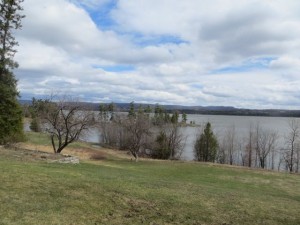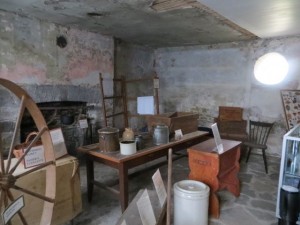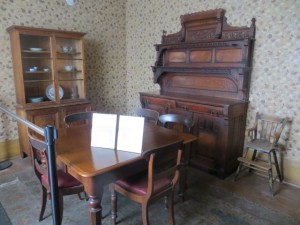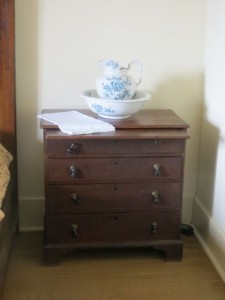Post Conference Review #3: Horaceville: Pinhey’s Point Historic Site
29 May 2013 – Annie Muirhead
methods, public engagement, sense of place, conference, The Public Historian, NCPH conference 2013, conference city review
Editor’s note: This post continues the series of conference city reviews published byThe Public Historian in the Public History Commons
Horaceville: Pinhey’s Point Historic Site, April 20, 2013. NCPH Annual Meeting, Ottawa, Ontario. The Pinhey’s Point Foundation. Tour leader: Bruce Elliott.
At Pinhey’s Point Historic Site, the house takes center stage as storyteller. Hamnett Pinhey started construction in 1820 and continued to expand throughout the first half of the nineteenth century. He named the house “Horaceville” after his eldest son, whom he hoped would inherit the property as a member of the landed gentry. When responsible government[1] wrested power from the old regime and granted it to the common people, the house’s increasingly dilapidated state expressed that failed colonial dream. Today, the Pinhey’s Point Foundation’s (PPF) approach of minimal intervention allows the house to speak for itself, enabling the visitor to glimpse moments from Horaceville’s entire life span.
Nine of us made the forty-five minute journey out to Pinhey’s Point on a surprisingly wintry Saturday, the last day of NCPH’s 2013 annual meeting. Presented with the exciting array of field trip options, my fascination with empire and colonialism steered me toward Pinhey’s Point. I wanted to see how Canada interprets its colonial past in the setting of a historic house museum. In addition to the usual visitor experience, we were also able to see behind the scenes with Bruce Elliott of Carleton University, who often uses the site in his courses.
A brief stop along the way helped place Pinhey’s Point in the larger context of the March Township, a settlement once divided between military gentlemen along the shore and Irish immigrants farther inland. By settling on the hill overlooking the sheltered harbor of Pinhey’s Point, Hamnett Pinhey declared his place among the former.

The sheltered harbor that made Pinhey’s Point an ideal spot for Hamnett Pinhey. (Photo courtesy of Annie Muirhead.)
He applied a stone facade to the front of Horaceville, where it faced the Ottawa River, but contented himself with faux finishes on the less visible walls. The public spaces within the house contributed to Pinhey’s gentlemanly presentation. Painted grain patterns gave plain pine floors and doors the appearance of more expensive woods; and Pinhey laid out rooms on the ground floor as an enfilade,[2] probably inspired by Europe’s great palaces.
Hamnett Pinhey’s lordly aspirations were cut short by circumstances beyond his control. Soon after his initial investment, the advent of responsible government curtailed the power of landed gentry in Canada. Moreover, his fashionable parcel of land on the riverbank would never produce as much as the fertile inland farms. The Pinhey family quickly fell into decline and never found the resources to replace all of Hamnett’s original decorations or furnishings.
The Pinheys’ loss has proved a boon to the PPF. Architect Julian Smith took charge of the restoration, choosing the path of minimal intervention. The visitor is treated to glimpses of Hamnett Pinhey’s mansion alongside the deteriorating home of the twentieth century Pinheys. The house retains much of its original contents, albeit some in a much-altered form. A once-fine drop leaf dining table now resides in the kitchen, covered in canvas, and the room Hamnett once used as a study remains in its later incarnation as a dining room—complete with linoleum from the early twentieth century. A text panel explains the room’s earlier use.

The kitchen, stripped of its modern remodeling. Just behind the spinning wheel is the drop-leaf dining table covered in canvas. (Photo courtesy of Annie Muirhead.)

Hamnett Pinhey’s library, transformed by later generations into a dining room. (Photo courtesy of Annie Muirhead.)
Throughout our tour, I could not identify a central narrative. Some rooms contained period artifacts and depicted the space’s use, while others function as exhibit space for rotating displays, often produced by college students or volunteers with funding from small project grants. Temporary exhibits from past years have been repurposed and displayed in many of Horaceville’s rooms. A few panels in the parlor tell about Hamnett Pinhey and the house’s construction, a single placard interprets the unusual second-floor privy, posters in the upstairs dining room detail the restoration process, a trellis in the master bedroom holds information about Pinhey’s gardens, and a meticulously reproduced 1880s gown occupies a place of honor in the sitting room. Most of these projects demonstrate excellent scholarship, but they stand independent of one another. Bruce Elliott did a great job guiding us through the house’s past, but on my own I would have had a difficult time piecing the story together from these scattered displays.
Currently, PPF and the City of Ottawa share responsibility for Pinhey’s Point. Ottawa owns the house and land, while PPF retains ownership of the collections. Most of the exhibits and interpretation come from the Foundation, which directs its efforts towards adult visitors. Ottawa runs the site during its open season (May through September), focusing their programming on children’s activities. The two organizations form a symbiotic relationship through which they successfully balance good scholarship with public interest, though neither party receives sizable funding. The PPF’s most recent exhibit, “Whose Astrolabe?” presents an excellent examination of the origins of a seventeenth-century astrolabe, facilitating discussion of cultural ownership and contested memory. PPF uses this single artifact to interpret key issues of post-colonial narrative, incorporating primary source research to confront old assumptions.
The concept of minimal intervention that guided Horaceville’s restoration has bared remarkable aspects of the house’s original construction. Julian Smith removed twentieth-century remodeling from the attached stone kitchen revealing the original hearth. He chose not to repair the walls and ceiling, leaving the structural underpinnings exposed in several places. This space may look “ugly” to some visitors, but permits a range of interpretive possibilities. In the sitting room, a single wall retains the remnants of original wallpaper while the other three bear relatively new coats of paint in a complementary green. In this particular space, I think the intervention has been a bit too minimal. A section of floral wallpaper border at the top of the wall looks like it could peel off at any time, crying out for a conservator to stabilize it.
For the most part, PFF has used conservation very strategically. A handful of artifacts have undergone full restoration, including the oldest piece in the furniture collection—a chest of drawers from the eighteenth century. Others, like the repurposed kitchen table, contribute to interpretation through their decay. This balance effectively allows the visitor to encounter Horaceville in several times at once.
Horaceville survives as a ghost of Canada’s colonial past, encompassing a myriad of might-have-beens. I could see Hamnett Pinhey’s hopes for greatness in the traces of luxury and attention paid to appearances. At the same time, his family’s failure to fulfill that promise emerges in the nineteenth-century furnishings that saw regular use until the 1970s. Although Bruce Elliott’s tour guided us skillfully through this dynamic interpretation, I think the installation of a cohesive narrative should be a priority to improve Pinhey’s Point interpretation for unguided visitors. Due to the snow, we did not get the chance to explore the grounds, but even without that additional attraction, I wish we had spent longer at Pinhey’s Point. I’m sure Horaceville has more stories to tell than those we had time to hear.
~ Annie Muirhead, New Mexico State University
[1] Canadians sought “representative and responsible” government in their struggle against the ruling elite in the early nineteenth century. See http://www.canadiana.ca/citm/specifique/responsable_e.html
[2] “A linear arrangement of a series of interior doors, as to a suite of rooms, so as to provide an unobstructed view when the doors are open.” American Heritage Dictionary. http://www.ahdictionary.com/word/search.html?q=enfilade&submit.x=36&submit.y=22.





